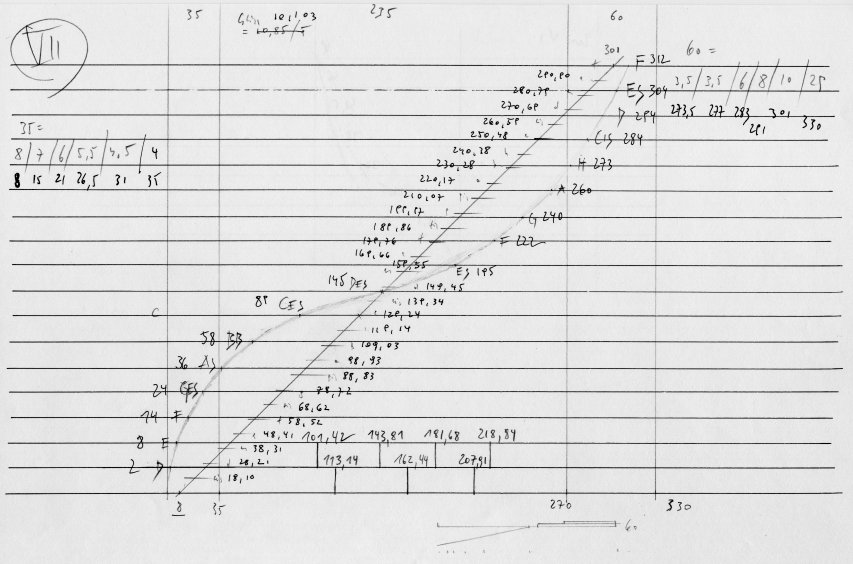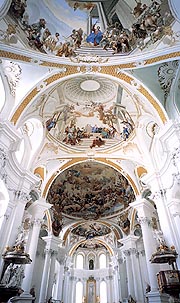Peter Ablinger:
ORGEL UND RAUSCHEN
(DIAPHANIE 3)
1998-2000
45', große Orgel, Bleigewichte, 2 Zuspiel-CDs
45', organ, lead weights, 2 prerecorded CDs
for Barbara Wieland and Peter Schulz
Performance CDs produced with technical support of Thomas Musil at IEM Graz
45 minutes. Organ and noise. 4 Loudspeakers, 2 CD-players. A piece in 7 parts inspired by Balthasar Neumann's monastery church in Neresheim, Germany, 18th century. "Diaphany" is the architectonical concept of the space within the space, and also one of the most long-running concepts in Peter Ablinger's work which can be retraced down to his earliest pieces: the sound within the sound. A highly virtuousic multilayered organ part "wraped" by just as much layers of different colored noise provoking a kaleidoscope of listening perspectives from history to illusion.

Basic lineament of part 7 from "Organ and Noise"
ORGAN AND NOISE ("DIAPHANY 3")
DIAPHANY
Since ever I have been searching for the sound within the sound within the sound. As a free jazz pianist, what fascinated me was the suspended, almost static slowness that unfolds in its high density and extreme speed.
NERESHEIM
I conceived this piece during an accidental visit to Neresheim, a Benedictine cloister church designed by Balthasar Neumann. Coincidentally, three weeks later I was asked to write a piece for Neresheim, and so from beginning a special diaphany or penetration seemed to define the piece: here the penetration of the earlier and the later.
RAUSCHEN (NOISE)
I take all tones - and because I like them all I don't remove any of them. A tone removed from somewhere would simultaneously emerge somewhere else. This is all I do: redistribute everything in space, which nevertheless always remains everything. In a sense: nothing is composed except the space - and the disappearance.
P.A., 3/2001

detail from organ part
ORGEL UND RAUSCHEN ("DIAPHANIE 3")
Diaphanie
Schon immer suche ich nach dem Klang im Klang im Klang. Schon als Freejazz-Pianist war das Faszinierende an der größten Dichte und rasendsten Geschwindigkeit, daß sich in ihr eine schwebende, fast statische Langsamkeit entfalten konnte.
Neresheim
Bei einem zufälligen Besuch in Neresheim habe ich dieses Stück konzipiert. Etwa 3 Wochen später erhielt ich die Möglichkeit, für Neresheim ein Stück zu machen. So scheint von Anfang an eine besondere Durchdringung oder Verschlungenheit das Stück auszumachen: hier die Verschlungenheit von früher und später.
Rauschen
Ich nehme alle Töne - und da mir alle gefallen, nehme ich keinen mehr weg. Ein Ton, irgendwo weggenommen, würde im gleichen Moment an einer anderen Stelle wieder auftauschen. Das ist alles, was ich tue: daß ich ALLES unterschiedlich im Raum verteile, aber es bleibt immer ALLES. In gewissem Sinne ist nichts komponiert, außer der Raum - und das Verschwinden.
P.A., 3/2001

Neresheim, the church
> Vorwort zur Partitur mit Beschreibung und Details zur Aufführung
> Preface for score with description and details for performance
> 1 page from the score
> listen to the beginning of part 4 (organ: Peter Schulz)
> CD released at Los Angeles River Records
> An Analysis of 'Orgel und Rauschen' by Marina Sudo
for score and performance-CDs, as well as for more information, contact the publisher:
 ZEITVERTRIEB WIEN BERLIN
ZEITVERTRIEB WIEN BERLIN
Bryan Eubanks, Gotzkowskystr. 15, D-10555 Berlin,
T: +49 / 176 / 47 39 29 97, zeitvertrieb@proton.me
see also:
> Orgel und Weltempfänger
> Instrumente und Rauschen
> WEISS / WEISSLICH 17, Instrument und Rauschen
> Rauschen, documentation
> Umgekehrte Perspektive / Inverted Perspective